 Backend Development
Backend Development
 C#.Net Tutorial
C#.Net Tutorial
 C language must memorize 18 classic programs that beginners of C language must know (collection)
C language must memorize 18 classic programs that beginners of C language must know (collection)
C language must memorize 18 classic programs that beginners of C language must know (collection)

AC languageHow do beginners learn code, read code and write code? I want to learn code but don’t know the direction. Who can give me a direction? For In C language, there are not many things to remember, it is basically just a few common statements plus some keywords. The thousands or even tens of thousands of lines of code you see are all written repeatedly using these statements and keywords. It's just that their logical functions are different. So how to quickly get started with C language code? It is recommended to read more and write more.
1. The first of 18 classic programs that must be memorized in C language is the multiplication table.
Use C language to output the 9*9 formula. There are 9 rows and 9 columns in total, i controls the rows and j controls the columns.
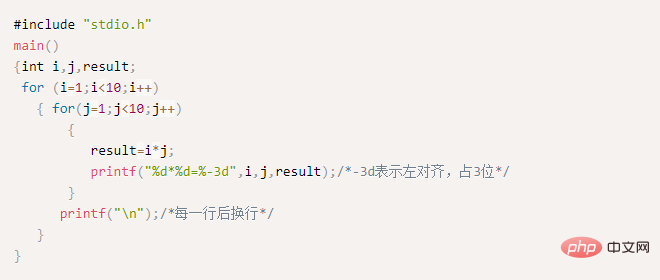
2. C language must memorize 18 classic programs for 4×4 array
The function of the following program is to convert a 4 The ×4 array is rotated 90 degrees counterclockwise and then output. The data of the original array is required to be randomly input. The new array is output in the form of 4 rows and 4 columns. Please complete the program in the blank space.

3. C language must memorize 18 classical problems related to classic programs
There is a pair of rabbits, the third one from birth A pair of rabbits are born every month starting from 3 months old, and another pair of rabbits are born every month after the rabbit reaches the third month. If the rabbits do not die, what is the total number of rabbits each month?
The pattern of rabbits is the sequence 1,1,2,3,5,8,13,21...

4. C language must Memorize 18 classic programs for prime numbers
Determine how many prime numbers there are between 101-200, and output all prime numbers and the number of prime numbers.
Program analysis: How to determine prime numbers: Use a number to divide 2 to sqrt (this number) respectively. If it can be divided evenly, it means that the number is not a prime number, otherwise it is a prime number.

5. C language must memorize the complete number-related codes of 18 classic programs
If a number is exactly equal to its factor The sum is called a "perfect number". For example, 6=1+2+3. Program to find all perfect numbers within 1000.
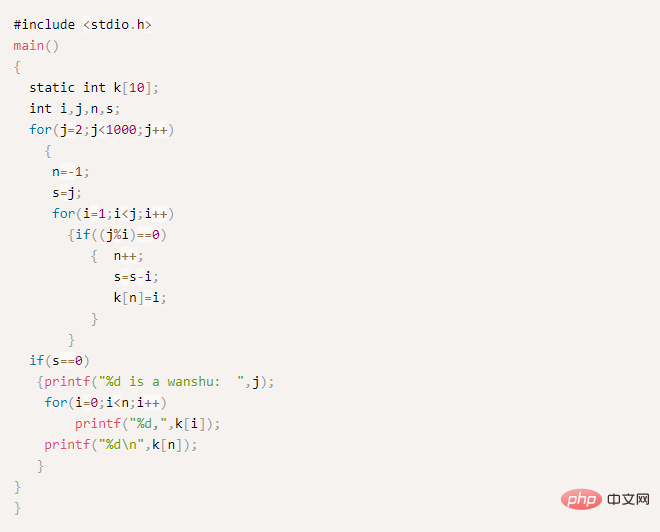
6. C language must memorize 18 classic programs for triangle printing
Programming to print right-angled Yang Hui triangle
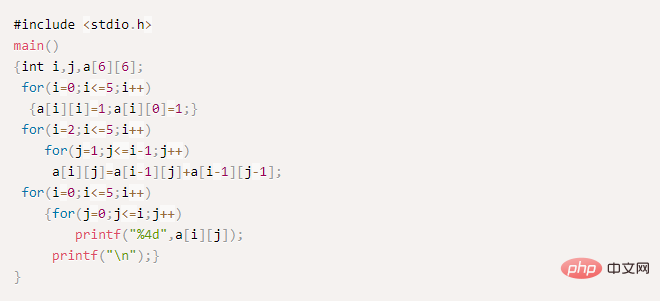
7. Question about the average score of 18 classic programs that must be memorized in C language
Enter the scores of 3 students in 4 courses through the keyboard, and find out respectively Average grade per student and average grade per course. All scores are required to be put into an array with 4 rows and 5 columns. When inputting, use spaces between data for the same person and press Enter for different people. The last column and the last row contain the average score of each student and the average score of each course respectively. and overall class average.
#include <stdio.h>
#include <stdlib.h>
main()
{ float a[4][5],sum1,sum2;
int i,j;
for(i=0;i<3;i++)
for(j=0;j<4;j++)
scanf("%f",&a[i][j]);
for(i=0;i<3;i++)
{ sum1=0;
for(j=0;j<4;j++)
sum1+=a[i][j];
a[i][4]=sum1/4;
}
for(j=0;j<5;j++)
{ sum2=0;
for(i=0;i<3;i++)
sum2+=a[i][j];
a[3][j]=sum2/3;
}
for(i=0;i<4;i++)
{ for(j=0;j<5;j++)
printf("%6.2f",a[i][j]);
printf("\n");
}
}8. C language must memorize the reverse output of 18 classic programs
Improve the program to output the input string in reverse order, such as inputting windows output swodniw.

9. The ninth C language must memorize 18 classic programs
The function of the following program is to select from the character array s Delete the characters stored in c.
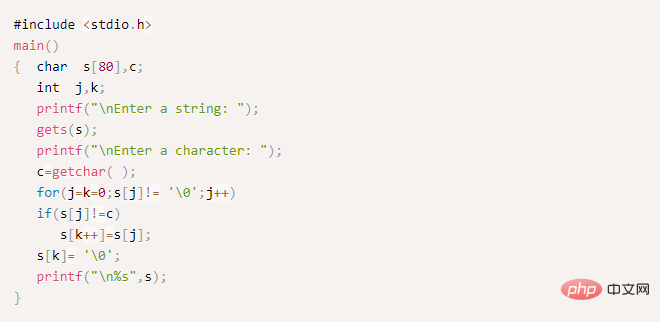
10. You must memorize 18 classic programs in C language----solve sorting problems
Write a void sort(int *x, int n) implements sorting the n data in the x array from large to small. n and array elements are input in the main function. Display the result on the screen and output it to the file p9_1.out
#include<stdio.h>
void sort(int *x,int n)
{
int i,j,k,t;
for(i=0;i<n-1;i++)
{
k=i;
for(j=i+1;j<n;j++)
if(x[j]>x[k]) k=j;
if(k!=i)
{
t=x[i];
x[i]=x[k];
x[k]=t;
}
}
}
void main()
{FILE *fp;
int *p,i,a[10];
fp=fopen("p9_1.out","w");
p=a;
printf("Input 10 numbers:");
for(i=0;i<10;i++)
scanf("%d",p++);
p=a;
sort(p,10);
for(;p<a+10;p++)
{ printf("%d ",*p);
fprintf(fp,"%d ",*p); }
system("pause");
fclose(fp);
}11. C language must memorize 18 classic programs to solve the problem of sorting from small to large
Known The elements in array a have been arranged in order from small to large. The function of the following program is to insert an input number into array a. After the insertion, the elements in array a are still arranged in order from small to large
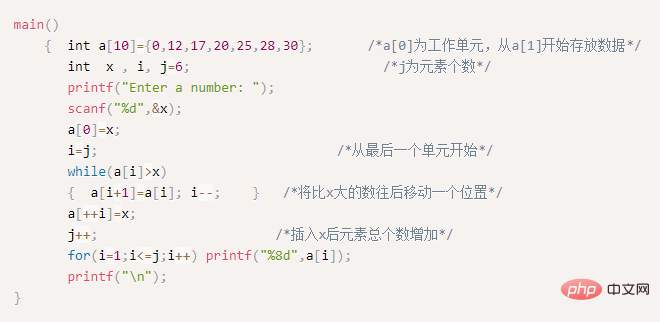
12、C语言必背18个经典程序之替换输出
编写函数replace(char *s,char c1,char c2)实现将s所指向的字符串中所有字符c1用c2替换,字符串、字符c1和c2均在主函数中输入,将原始字符串和替换后的字符串显示在屏幕上,并输出到文件p10_2.out中
#include<stdio.h>
replace(char *s,char c1,char c2)
{ while(*s!='\0')
{ if (*s==c1)
*s=c2;
s++;
}
}
main()
{ FILE *fp;
char str[100],a,b;
if((fp=fopen("p10_2.out","w"))==NULL)
{ printf("cannot open the file\n");
exit(0); }
printf("Enter a string:\n");
gets(str);
printf("Enter a&&b:\n");
scanf("%c,%c",&a,&b);
printf("%s\n",str);
fprintf(fp,"%s\n",str);
replace(str,a,b);
printf("The new string is----%s\n",str);
fprintf(fp,"The new string is----%s\n",str);
fclose(fp);
}13、C语言必背18个经典程序之查找
在一个字串s1中查找一子串s2,若存在则返回子串在主串中的起始位置,不存在则返回-1。

14、C语言必背18个经典程序,用指针变量输出结构体数组元素。
struct student
{
int num;
char *name;
char sex;
int age;
}stu[5]={{1001,"lihua",'F',18},{1002,"liuxing",'M',19},{1003,"huangke",'F',19},{1004,"fengshou",'F',19},{1005,"Wangming",'M',18}};
main()
{int i;
struct student *ps;
printf("Num \tName\t\t\tSex\tAge\t\n");
/*用指针变量输出结构体数组元素。*/
for(ps=stu;ps<stu+5;ps++)
printf("%d\t%-10s\t\t%c\t%d\t\n",ps->num,ps->name,ps->sex,ps->age);
/*用数组下标法输出结构体数组元素学号和年龄。*/
for(i=0;i<5;i++)
printf("%d\t%d\t\n",stu[i].num,stu[i].age);
}15、C语言必背18个经典程序之十五
建立一个有三个结点的简单链表
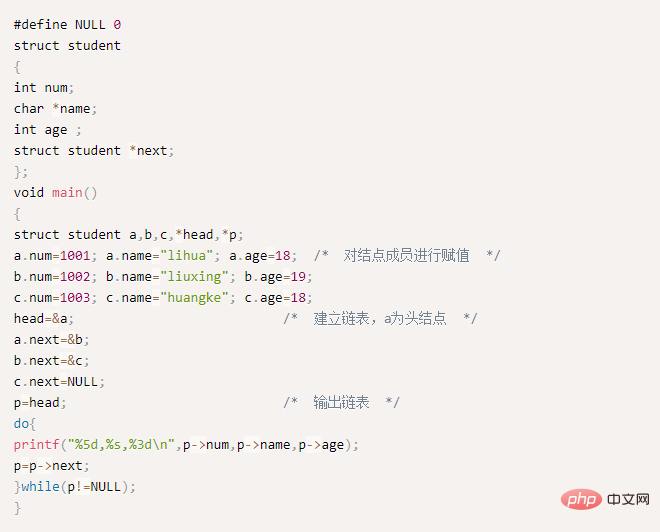
16、C语言必背18个经典程序之冒泡排序
冒泡排序,从小到大,排序后结果输出到屏幕及文件myf2.out
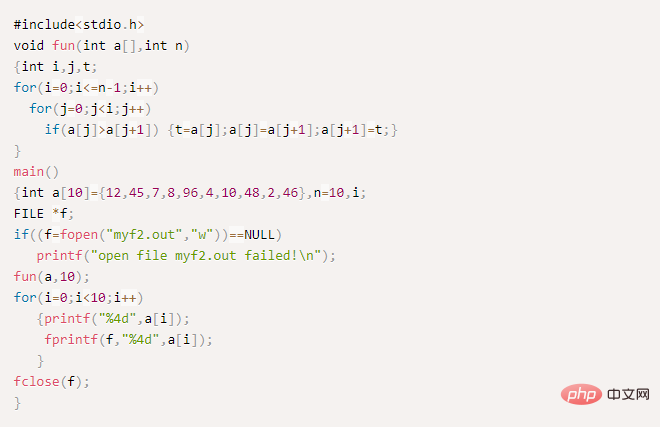
17、输出字符串的C语言必背经典程序
输入一个字符串,判断其是否为回文。回文字符串是指从左到右读和从右到左读完全相同的字符串。
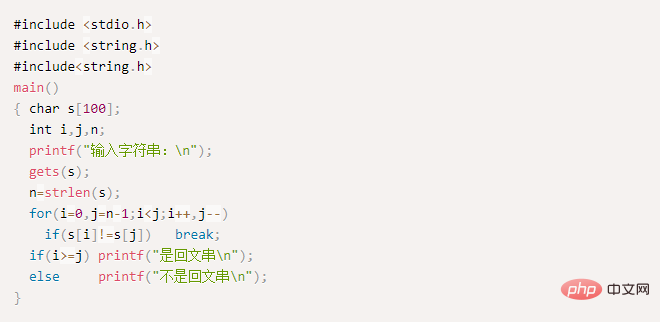
18、C语言必背18个经典程序之编写函数
编写函数countpi,利用公式计算π的近似值,当某一项的值小于10-5时,认为达到精度要求,请完善函数。将结果显示在屏幕上并输出到文件p7_3.out中。
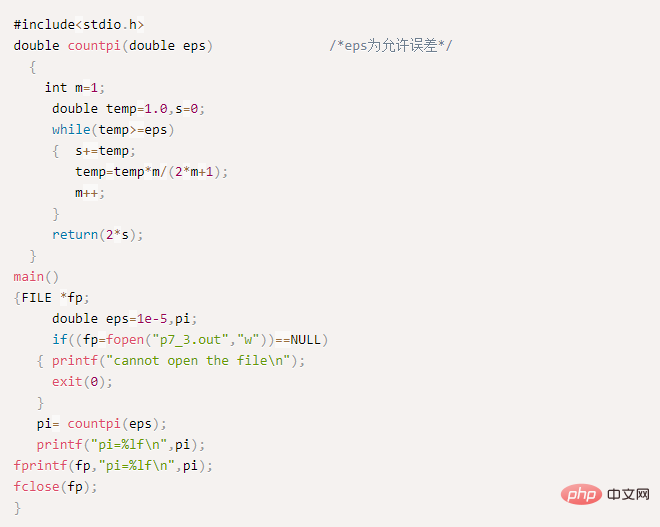
相关推荐:《C视频教程》
The above is the detailed content of C language must memorize 18 classic programs that beginners of C language must know (collection). For more information, please follow other related articles on the PHP Chinese website!

Hot AI Tools

Undresser.AI Undress
AI-powered app for creating realistic nude photos

AI Clothes Remover
Online AI tool for removing clothes from photos.

Undress AI Tool
Undress images for free

Clothoff.io
AI clothes remover

Video Face Swap
Swap faces in any video effortlessly with our completely free AI face swap tool!

Hot Article

Hot Tools

Notepad++7.3.1
Easy-to-use and free code editor

SublimeText3 Chinese version
Chinese version, very easy to use

Zend Studio 13.0.1
Powerful PHP integrated development environment

Dreamweaver CS6
Visual web development tools

SublimeText3 Mac version
God-level code editing software (SublimeText3)

Hot Topics
 1386
1386
 52
52
 C language data structure: data representation and operation of trees and graphs
Apr 04, 2025 am 11:18 AM
C language data structure: data representation and operation of trees and graphs
Apr 04, 2025 am 11:18 AM
C language data structure: The data representation of the tree and graph is a hierarchical data structure consisting of nodes. Each node contains a data element and a pointer to its child nodes. The binary tree is a special type of tree. Each node has at most two child nodes. The data represents structTreeNode{intdata;structTreeNode*left;structTreeNode*right;}; Operation creates a tree traversal tree (predecision, in-order, and later order) search tree insertion node deletes node graph is a collection of data structures, where elements are vertices, and they can be connected together through edges with right or unrighted data representing neighbors.
 The truth behind the C language file operation problem
Apr 04, 2025 am 11:24 AM
The truth behind the C language file operation problem
Apr 04, 2025 am 11:24 AM
The truth about file operation problems: file opening failed: insufficient permissions, wrong paths, and file occupied. Data writing failed: the buffer is full, the file is not writable, and the disk space is insufficient. Other FAQs: slow file traversal, incorrect text file encoding, and binary file reading errors.
 C language multithreaded programming: a beginner's guide and troubleshooting
Apr 04, 2025 am 10:15 AM
C language multithreaded programming: a beginner's guide and troubleshooting
Apr 04, 2025 am 10:15 AM
C language multithreading programming guide: Creating threads: Use the pthread_create() function to specify thread ID, properties, and thread functions. Thread synchronization: Prevent data competition through mutexes, semaphores, and conditional variables. Practical case: Use multi-threading to calculate the Fibonacci number, assign tasks to multiple threads and synchronize the results. Troubleshooting: Solve problems such as program crashes, thread stop responses, and performance bottlenecks.
 CS-Week 3
Apr 04, 2025 am 06:06 AM
CS-Week 3
Apr 04, 2025 am 06:06 AM
Algorithms are the set of instructions to solve problems, and their execution speed and memory usage vary. In programming, many algorithms are based on data search and sorting. This article will introduce several data retrieval and sorting algorithms. Linear search assumes that there is an array [20,500,10,5,100,1,50] and needs to find the number 50. The linear search algorithm checks each element in the array one by one until the target value is found or the complete array is traversed. The algorithm flowchart is as follows: The pseudo-code for linear search is as follows: Check each element: If the target value is found: Return true Return false C language implementation: #include#includeintmain(void){i
 How to output a countdown in C language
Apr 04, 2025 am 08:54 AM
How to output a countdown in C language
Apr 04, 2025 am 08:54 AM
How to output a countdown in C? Answer: Use loop statements. Steps: 1. Define the variable n and store the countdown number to output; 2. Use the while loop to continuously print n until n is less than 1; 3. In the loop body, print out the value of n; 4. At the end of the loop, subtract n by 1 to output the next smaller reciprocal.
 C language data structure: the key role of data structures in artificial intelligence
Apr 04, 2025 am 10:45 AM
C language data structure: the key role of data structures in artificial intelligence
Apr 04, 2025 am 10:45 AM
C Language Data Structure: Overview of the Key Role of Data Structure in Artificial Intelligence In the field of artificial intelligence, data structures are crucial to processing large amounts of data. Data structures provide an effective way to organize and manage data, optimize algorithms and improve program efficiency. Common data structures Commonly used data structures in C language include: arrays: a set of consecutively stored data items with the same type. Structure: A data type that organizes different types of data together and gives them a name. Linked List: A linear data structure in which data items are connected together by pointers. Stack: Data structure that follows the last-in first-out (LIFO) principle. Queue: Data structure that follows the first-in first-out (FIFO) principle. Practical case: Adjacent table in graph theory is artificial intelligence
 The concept of c language functions and their definition format
Apr 03, 2025 pm 11:33 PM
The concept of c language functions and their definition format
Apr 03, 2025 pm 11:33 PM
C language functions are reusable code blocks, receive parameters for processing, and return results. It is similar to the Swiss Army Knife, powerful and requires careful use. Functions include elements such as defining formats, parameters, return values, and function bodies. Advanced usage includes function pointers, recursive functions, and callback functions. Common errors are type mismatch and forgetting to declare prototypes. Debugging skills include printing variables and using a debugger. Performance optimization uses inline functions. Function design should follow the principle of single responsibility. Proficiency in C language functions can significantly improve programming efficiency and code quality.
 Troubleshooting tips for processing files in C language
Apr 04, 2025 am 11:15 AM
Troubleshooting tips for processing files in C language
Apr 04, 2025 am 11:15 AM
Troubleshooting Tips for C language processing files When processing files in C language, you may encounter various problems. The following are common problems and corresponding solutions: Problem 1: Cannot open the file code: FILE*fp=fopen("myfile.txt","r");if(fp==NULL){//File opening failed} Reason: File path error File does not exist without file read permission Solution: Check the file path to ensure that the file has check file permission problem 2: File reading failed code: charbuffer[100];size_tread_bytes=fread(buffer,1,siz



